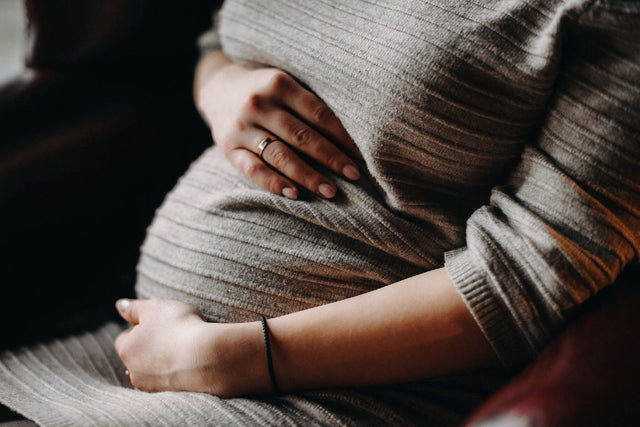What Are the Signs of Preeclampsia? A Guide for Expectant Parents

On This Page
You may have noticed that your doctor has watched your blood pressure like a hawk throughout your pregnancy. That’s because a spike in blood pressure may point to preeclampsia: the most common medical disorder during pregnancy…and the reason behind 15% of premature deliveries.
So, how do you know if you might be developing preeclampsia?
What is preeclampsia in pregnancy?
Preeclampsia is a pregnancy complication marked by high blood pressure, swelling of the extremities, and signs that the kidneys and liver are not working right, such as protein in the urine (this is why you’re asked to pee in a cup during nearly every doctor’s visit!). Preeclampsia happens in 5 to 8% of pregnancies, usually after 20 weeks of gestation. Although it’s potentially a serious condition, most moms with preeclampsia go on to deliver healthy babies.
What causes preeclampsia?
Like so many things in medicine, we’re not totally sure what causes preeclampsia. What we do know is that it usually occurs during first-time pregnancies, affecting women who:
- are pregnant with multiples
- get pregnant 10 years or more after their last pregnancy
- are under 20 or over 40
- are African American
- are overweight or obese
- have polycystic ovary syndrome (PCOS)
- have a history of diabetes, high blood pressure, autoimmune disorders, or a kidney disorder
- have a close relative who had preeclampsia
- conceived through in vitro fertilization (IVF)
- had preeclampsia with a previous pregnancy
What are the symptoms of preeclampsia?
Your midwife or doctor will check for early signs of preeclampsia, like is a spike in blood pressure above 140/90, and protein in the urine. The tricky part is that you may feel perfectly normal (which is why we must do the tests!). That’s why it’s so important to go to all your prenatal appointments. Those preeclampsia symptoms and early signs often progress to fluid retention or edema (swelling of the hands, feet, legs, and/or face).
More severe preeclampsia can cause intense headaches, blurry vision, nausea, upper abdominal pain, sudden weight gain, shortness of breath, rapid heartbeat, and infrequent urination (with dark yellow urine). Don’t ignore these symptoms…if you think you have them, get checked right away!
Signs of Preeclampsia
- persistent headache
- seeing spots, blurry vision, or other changes in eyesight
- swelling of hands or face
- shortness of breath
- pain in the upper abdomen or shoulder
- nausea and vomiting (in the second half of pregnancy)
- sudden weight gain
How does preeclampsia affect the baby and mother?
With mild preeclampsia, a provider will monitor you until your little one can be safely delivered. But if the condition worsens, it can impact both of your health.
Preeclampsia reduces blood flow to the placenta. And that may reduce the things your baby needs for good fetal growth (oxygen and nutrients). As for Mom, in rare cases (about 1 in 200 preeclampsia pregnancies), the condition progresses to eclampsia, putting her at risk for seizures and stroke.
How to Prevent Preeclampsia
Preeclampsia cannot be prevented, but healthy habits can help you keep blood pressure low. Throughout pregnancy, drink plenty of water, get regular exercise, avoid alcohol and excessive caffeine, take your prenatal vitamins, eat nutritious foods, and go easy with the saltshaker (too much sodium can boost your blood pressure). If you already suffer from high blood pressure when you become pregnant, ask your doctor about taking a daily low-dose aspirin to help control it.
Another habit that may keep preeclampsia at bay is to take care of your pearly whites! One study showed that having a history of gum disease was linked to preeclampsia…so don’t forget to floss!
How is preeclampsia treated?
Mild preeclampsia can be managed with careful monitoring. If it becomes more severe, doctors often prescribe blood pressure lowering medications and prevent seizures. Corticosteroids may be used to improve the mom’s liver function and platelet count while simultaneously speeding up the baby’s lung development to prepare for an early delivery. The only way to truly cure preeclampsia is to deliver your baby. Your health provider will balance the risks of preeclampsia against the risks of delivering early, often inducing at about 34 weeks if necessary.
Signs of Preeclampsia After Birth
While most parents with preeclampsia will welcome healthy babies and fully recover, some will develop complications after birth. Preeclampsia can evolve into severe preeclampsia, eclampsia, or HELLP syndrome (a rare but serious condition that affects the liver and blood). After your baby’s arrival, your doctor will continue to monitor your blood pressure and other preeclampsia symptoms so they can provide you the care you need.